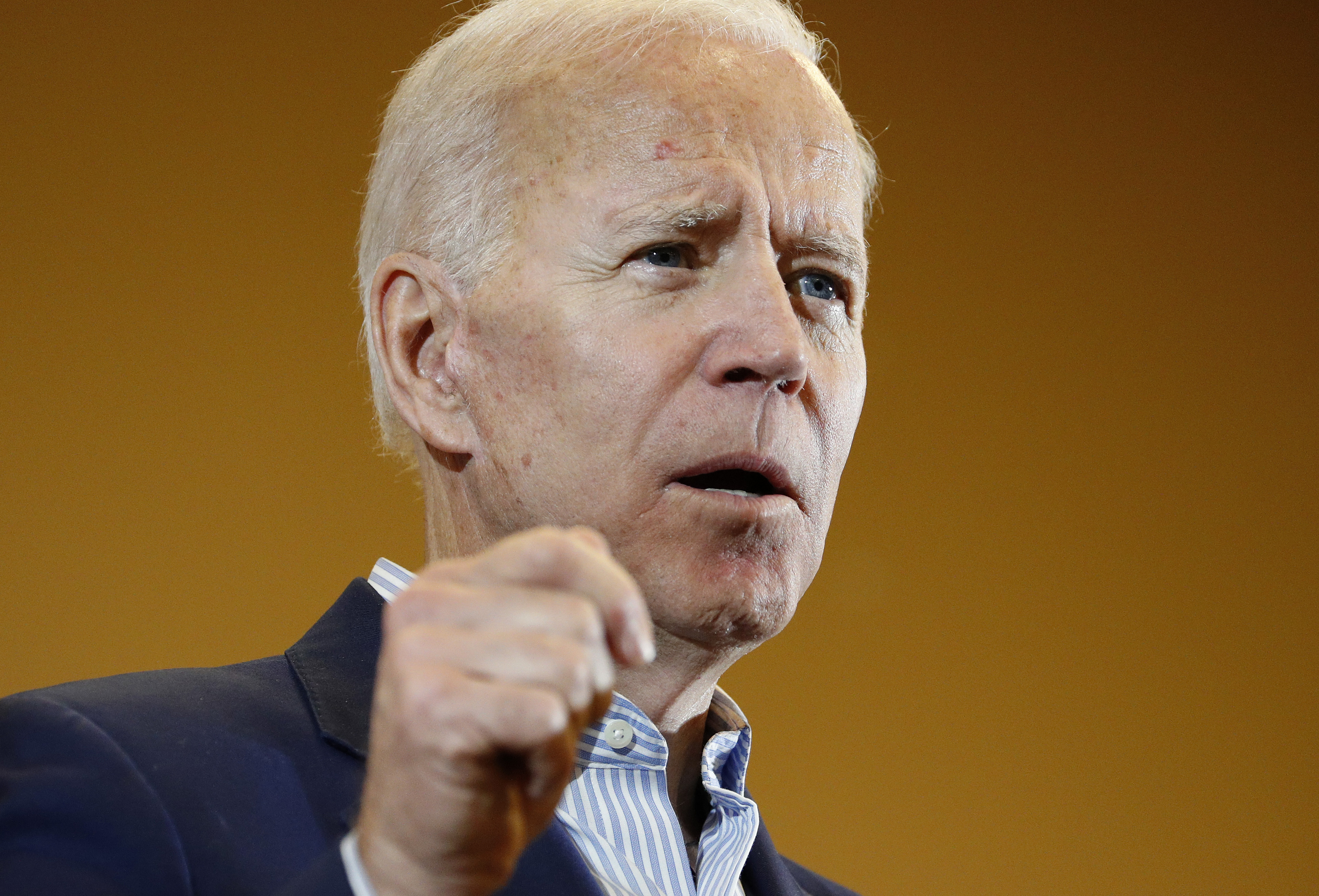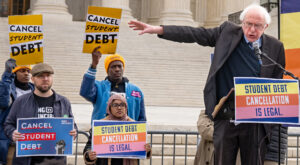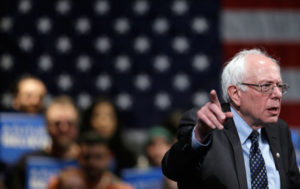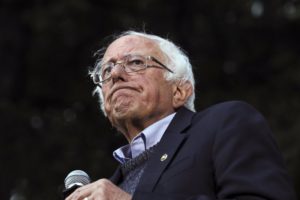Biden Heads to Iowa Looking for a Rebound in Key State
Biden’s aides acknowledge that he must sharpen his pitch before the Feb. 3 caucuses. Former Vice President Joe Biden. (John Locher / AP)
Former Vice President Joe Biden. (John Locher / AP)
DES MOINES, Iowa—Joe Biden’s eight-day bus tour across Iowa comes with a message: Reports of his demise in the nation’s first presidential caucus state have been greatly exaggerated.
Biden’s aides acknowledge that he must sharpen his pitch before the Feb. 3 caucuses that launch Democrats’ 2020 voting. Yet the former vice president’s advisers reject any characterization of the 18-county swing that was beginning Saturday as a campaign reset, even with polls showing that Biden’s standing in Iowa has slipped in recent months.
They frame the extended trip as an effort to demonstrate wide appeal and harden support across a Democratic electorate whose top priority is defeating President Donald Trump. Conversations with advisers and supporters reveal a quiet confidence that the 77-year-old candidate retains a broad base of support and is well-situated to recover lost ground.
“As people get closer and closer to February, they become more and more practical about this,” said former Iowa Gov. Tom Vilsack, who recently gave Biden his most high-profile Iowa endorsement yet. “He can make the strongest case, among all the candidates, that he is in a position to get things done, and he is in a position to win.”
Iowa polls suggest that Biden, while a front-runner nationally, is in a jumble near the top. South Bend, Ind., Mayor Pete Buttigieg appears to hold a narrow edge over Biden and Massachusetts Sen. Elizabeth Warren, 70, and Vermont Sen. Bernie Sanders, 78. The senators have animated the party’s left flank, while the 37-year-old Buttigieg joins Biden in Democrats’ moderate wing but is calling for generational change.
Biden opened November with an underwhelming speech at the state party’s “Liberty & Justice” gala. While Buttigieg and Warren roused thousands of supporters in a Des Moines arena, Biden ticked through his standard applause lines as whole sections of seats purchased by his campaign sat empty.
In southeast Iowa, the state party’s Rural Caucus vice chairman says Biden’s footprint isn’t visible. “I know the names of the people who are supporting various other candidates,” Glenn Hurst said. “But in terms of people out there knocking on doors, who attend other campaign events, district events, I can’t name a member of the southeast Iowa Democrats who’s supporting Joe Biden.”
Fairly or not, Biden’s national staff has fueled skeptical assessments with pronouncements that he doesn’t have to win Iowa to win the nomination. Iowa is overwhelmingly white; Biden’s national advantage leans heavily on non-white voters who help determine outcomes in Nevada, South Carolina and many March 3 Super Tuesday states.
Yet all the handwringing misses key variables in Iowa, according to Vilsack and other Biden supporters.
They contend that, public enthusiasm aside, Biden has the broadest range of support both demographically and geographically, especially in rural and small-town Iowa and among the growing minority population that, while small, could prove important with so many candidates dividing the overall caucus vote. Those Biden organizers that get so much criticism, the campaign says, spend their days not with local party officials, but with volunteers knocking on doors and making calls. Their focus: reliable caucus participants, plus disaffected Republicans and independents.
“The media seems to have picked up this narrative that the Biden campaign is not doing well or not as well as it should,” said longtime party activist and Biden supporter Phyllis Hughes Ewing, daughter of a former Iowa governor and U.S. senator. “I’m on the phones with voters two nights a week for several hours at a pop. I’m a boot on the ground, and that’s not what I’m seeing.”
Collectively, it’s a wide-net strategy the campaign predicts will yield a surprising delegate haul from Iowa’s complex caucus process.
The bullishness starts with the viability threshold requiring candidates to get 15% support in a given precinct to have votes counted toward delegates. Biden’s team believes he’ll be viable in every one of the 1,679 precincts on caucus night, a reach even other leading candidates may not match. Then, they believe Biden will be a top beneficiary of “realignment” votes — subsequent ballots that allow voters who supported a nonviable candidate to choose another who’s still standing.
That process could be a double boost for Biden, their theory goes. First, top contenders like Warren or Buttigieg whose support might be anchored in more liberal cities and suburbs would get no practical benefit from first-ballot votes in more rural precincts where they fall short of 15%. Second, several of the lower tier candidates running as moderates — Minnesota Sen. Amy Klobuchar, for example — could fall short of viability across much of the state. Biden advisers confirmed they already are mapping out realignment ballot strategy.
Two other key Democratic constituencies also are in play in Iowa, even if they aren’t the dominant forces they are in other states: organized labor and minority voters.
Biden won the endorsement of the International Association of Fire Fighters at the outset of his campaign, and the organization already has tapped its locals across the state to canvass. “We understand what needs to be done to get people out to caucus,” said Harold Schaitberger, the union’s national president, adding that he already has representatives on the ground and will have organizers in precincts across the state on caucus night.
For minority outreach, the campaign recently hired state Rep. Ras Smith, a member of the Legislature’s Black Caucus. He plans to hold caucus training events and outreach for minority voters who may be first-time participants. The campaign also is making an aggressive play for Latino voters, with more than a dozen bilingual organizers, including deputy political director Claudia Chavez.
Beyond the complexities of caucus rules and the nuances of turnout, Biden is perhaps leaning most strongly on an Iowa precedent for moderation. His preferred model is 2004, when Howard Dean wowed progressives for much of 2003, only to watch John Kerry come from behind as voters embraced the establishment favorite as the ideal to take on Republican President George W. Bush.
“History does indicate that Iowans start out with a very progressive-leaning focus early in the race but come home to a pragmatic, presidential choice at the end,” said Matt Paul, who ran Hillary Clinton’s successful 2016 Iowa campaign.
Among Kerry’s key backers in 2016: the firefighters’ union.
Schaitberger smiled as he recalled a newspaper headline in late fall of 2003: “Kerry dead in the water.”
Your support matters…Independent journalism is under threat and overshadowed by heavily funded mainstream media.
You can help level the playing field. Become a member.
Your tax-deductible contribution keeps us digging beneath the headlines to give you thought-provoking, investigative reporting and analysis that unearths what's really happening- without compromise.
Give today to support our courageous, independent journalists.






You need to be a supporter to comment.
There are currently no responses to this article.
Be the first to respond.